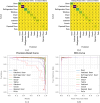Leveraging retinanet based object detection model for assisting visually impaired individuals with metaheuristic optimization algorithm
- PMID: 40341297
- PMCID: PMC12062455
- DOI: 10.1038/s41598-025-99903-y
Leveraging retinanet based object detection model for assisting visually impaired individuals with metaheuristic optimization algorithm
Abstract
Visually impaired individuals suffer many problems in handling their everyday activities like road crossing, writing, finding an object, reading, and so on. However, many navigation methods are available, and efficient object detection (OD) methods for visually impaired people (VIP) need to be improved. OD is the most crucial contribution of computer vision (CV) and plays an important part in recognizing and finding objects in the image. The aged and visually challenged people can identify different objects accurately under some constraint features like scaled, occlusion, illuminated, and blurred nature in different real world. A considerable number of studies are performed in the domain of real-time object recognition using deep learning (DL). The DL-based methods remove the features autonomously and classify and detect the objects. This paper proposes a novel Object Detection Model for Visually Impaired Individuals with a Metaheuristic Optimization Algorithm (ODMVII-MOA) technique. The proposed ODMVII-MOA technique aims to improve OD methods in real-time with advanced techniques to detect and recognize objects for disabled people. At first, the image pre-processing stage applies the Weiner filter (WF) method to enhance image quality by eliminating the unwanted noise from the data. Furthermore, the RetinaNet technique is utilized for the OD process to recognize and locate objects within an image. Besides, the proposed ODMVII-MOA method employs the EfficientNetB0 method for the feature extraction process. For the classification process, the LSTM-AE method is employed. Finally, the Dandelion Optimizer (DO) method adjusts the hyperparameter range of the LSTM-AE method optimally and results in better performance of classification. The experimental validation of the ODMVII-MOA model is verified under the indoor OD dataset and the outcomes are determined regarding different measures. The comparison study of the ODMVII-MOA model portrayed a superior accuracy value of 99.69% over existing techniques.
Keywords: Computer vision; Dandelion optimizer; Deep learning; Feature extraction; Object detection; Visually impaired individuals.
© 2025. The Author(s).
Conflict of interest statement
Declarations. Competing interests: The authors declare no competing interests.
Figures













References
-
- Bhandari, A., Prasad, P. W. C., Alsadoon, A. & Maag, A. Object detection and recognition: using deep learning to assist the visually impaired. Disabil. Rehabilitation: Assist. Technol.16 (3), 280–288 (2021). - PubMed
-
- Naqvi, K., Hazela, B., Mishra, S. & Asthana, P. Employing real-time object detection for visually impaired people. In Data Analytics and Management: Proceedings of ICDAM (pp. 285–299). Springer Singapore. (2021).
-
- Theodorou, L. et al. October. Disability-first dataset creation: Lessons from constructing a dataset for teachable object recognition with blind and low vision data collectors. In Proceedings of the 23rd International ACM SIGACCESS Conference on Computers and Accessibility (pp. 1–12). (2021).
-
- Abid Siddique, R. V. & Naik, S. A Survey on Gesture Control Techniques for Smart Object Interaction in Disability Support. Electronics, 12, p.512. (2023).
MeSH terms
Grants and funding
LinkOut - more resources
Full Text Sources

